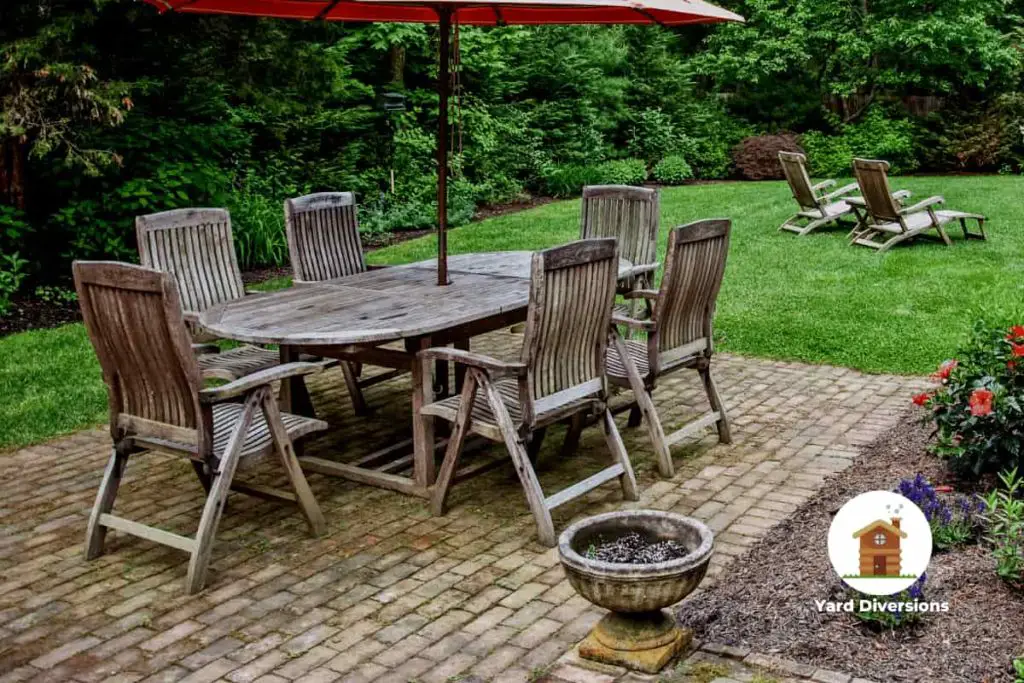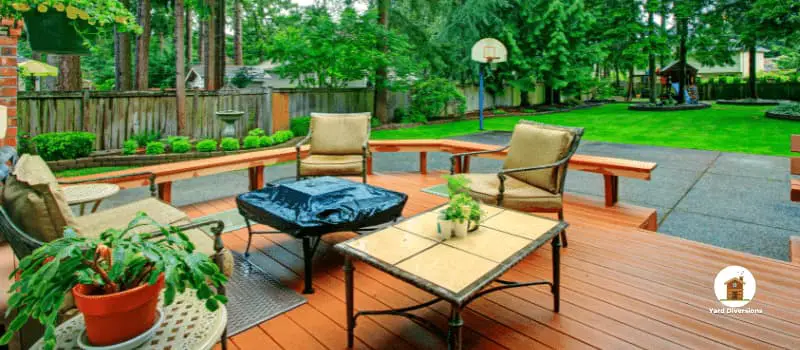A patio is a great spot to unwind and spend time with your loved ones after a long, tiring day. Not to mention that they make a wonderful outdoor setting to host a BBQ or dinner party.
Most importantly, a well-designed patio can enhance the appearance of your house in the best possible way. But what size is the average patio?
The average small patio size is about 7 ft X 7 ft. For something slightly larger, it can be about 12 ft x 14 ft. And large patios can be 14 ft x 18 ft. This gives you a lot of space to install all kinds of furniture and also a fire pit.
Figuring out the size of your patio is more crucial than you might think. If you don’t want to end up with a patio that is either too big or too small, you need to figure out which size will suit your house the best.
Lucky for you, this guide will be all about patio size and how to choose the one that’s best for you.

Does Patio Size Matter?
The short answer to this question is a big yes! Patio size does matter a lot. That is if you want to have a functional patio.
The goal of having a patio can differ from person to person. You might want to have an outdoor lounging space or a dining space.
Living room patios are also popular today. If you want your patio to serve its purpose correctly, the right size is important.
A patio that is too small will feel cramped along with feel generally uncomfortable to move around in and enjoy.
The chairs will be hitting each other, people bumping into each other and the table can overextend to the garden bed.
On the other hand, a large patio can be expensive. If you do not need a large one, then it makes no sense to spend the money on it.
The key here is to find the right balance and see what works for you. Getting the most out of the space is important.
Average Patio Size
Determining the right size for your patio is crucial. It can increase or decrease its functionality.
So, knowing the average size of a patio will give you a good idea of where to start.
From there you can tweak it depending on the different sizes to fit your needs.
The average patio size for a small one is about 7 feet X 7 feet. Which results in a total of 49 Sq feet of space to work with.
For something slightly larger, like a medium one, you are looking at about 12 feet x 14 feet or 168 Sq feet of space for everything.
Then with a large patio, this size can be 14 feet x 18 feet. This gives you a total of 288 sq feet of space to work with which fits far more furniture, cooking space, and relaxing areas.
Let’s break down the different kinds of patios along with their size. And then I will tell you what they are used for.
From there, you can make a more informed decision about the right patio size for you.
Bistros
If you have limited space, a bistro patio can be a perfect choice. A well-designed bistro patio can host different small-scale occasions. Bistro patios are on the smaller side. They can be 6 ft to 7 ft in diameter.
The challenge with a bistro patio is obviously the size since smaller spaces need designs to be more clever.
It needs to be large enough to house tables, chairs, and people but also not too big. Most bistro patios are built adjacent to homes.
So, you want to keep the color tone of the patio pretty neutral. Simple tones will help it complement your house’s façade.
As for the stamp pattern, your choice needs to be something smaller with less detail work.
Sundecks
Sundeck patios can have space for lounge chairs, about 2 ft x 6 ft. It can even have cocktail tables with 3 ft or so of walking space. There can be space around the swimming pools as well.
Here you are looking for at least 3 ft to 5 ft of space. This will prevent people from accidentally falling into the swimming pool. That is something you do not want.
Living Room
Living room patios are very popular right now. They can serve as outdoor living spaces. So, naturally, that makes them quite large.
This is because they need to be able to accommodate a lot of things like chairs, tables, couches, and also a fireplace or pit.
The ideal size can be 16 ft x 18 ft. if you have the right space, designing and planning are important here.
You need to ensure that everything feels cohesive. It can be easy to get carried away with such a large space. But you need to be methodical here to make the right use of the large space.
Create a list of furniture and necessities you want to include. Sometimes, you might not have room for everything. This is where you need to think about it for a bit. How do you want it to feel?
A central conversational space or somewhere everyone can get together is a must. It will give your patio a sense of intimacy.
And also, a focal point like a fire pit will elevate the overall design. A pergola, gazebo, or decorative concrete column can be used to shade your living room from harsh sun rays.
Dining (Outdoor)
One of the most common uses of patio space is to host feasts. And outdoor dining patios can easily give you that sense of joy.
It allows you to host awesome parties and feasts. For outdoor dining patios, you need to have at least 10 ft to 11 ft of space.
This allows you to fit a 6 – 8 person dining table which can be 48 inches. If you want to include multiple large dining tables, then you should have 12 ft to 14 ft of space for each.
This is because it will make pulling out the chairs much more convenient. And people will not bump their chairs into other chairs.

Figuring Out The Right Patio Size For You
It can get overwhelming designing a patio. But there are ways you make it go much smoother. When it comes to finding out the right patio size for you, there are some key factors.
Taking these into account will help you land on a functional patio size that will be within budget. So, let’s get started on the things you need to consider.
Size Of Your Yard
Simply put, this will be your limiting factor. You cannot work with more land than you already have. So, the size of your yard or whichever space you want to build out your patio on is important.
You also need to balance the patio here. You do not want to have too large of a patio. Otherwise, it might end up overshadowing your house. And a small patio compared to your house will get lost.
You can use your ground-floor rooms as a point of reference. See what kind of patio works for the space you have.
Intended Patio Use
Another important point of consideration is how you intend to use the patio. Depending on why you are building the patio in the first place, you could determine the size. This sounds pretty easy.
But if you are not paying attention, you might miss a lot of things. Starting to build a patio without fixing a use case will leave you lost.
You should ask yourself what you want a patio for. Do you wish to host dinner parties with lots of people, or do you want to keep it moderately intimate with a few people?
You might want it to be only a few people most of the time, but want to host large parties from time to time. Of course, large parties might not be possible with a small yard. But you get the idea here.
How you intend to use the space is important since you are working towards a goal. Think about what functionalities you want.
The Furniture You Want To Install
Then there is also the kind and the amount of furniture you want to install. How big your patio will be can depend a lot on the number of furniture you have.
When you have items that are larger like a dining table, chairs, and lounges, you will surely need something larger.
For a couple of lounge chairs and a small fire pit, you might not need a big patio. But then again, there are some rules of thumb you can follow. These will help make it easier.
For 2 to 4 chairs, you need to have about 35 to 65 Sq ft available, respectively. Add another couch to this then the space needs to be at least 130 Sq ft.
If you have already bought all your furniture, then you can try laying it out and see just how much space you would need.
This can help determine your patio size.
Patio Type
Lastly, there is the patio type itself. As I mentioned, different patios will be of different shapes.
For a smaller, cozier patio, a small space would do building something like a bistro patio. However, if you want something bigger, a larger land area is needed.
Depending on the type of patio, the functionalities and amenities will change. For a dining patio, you have to consider how many people you want to sit with at the dining table. Your dining tables need to be that big. And same goes for the patio. It needs to fit the table.
Living room patios are some of the largest styles since they act as outdoor living spaces. There will be lounge chairs, a fire pit, tables, and a focal point. All these will need lots of space.
So, the type is important. You need to think about whether you have the right amount of space in your yard for the patio you want.
Patio Sizing Tips
Well, you know what factors to consider when deciding on your ideal patio size. In some cases, there will not be much you can do.
For example, if your yard is small, to begin with. But that does not have to mean that you cannot have the patio of your dreams.
I will give you some super helpful tips to help you get the exact kind of patio you want. These are tried and tested tips.
Buy Furniture First
This might seem a bit counterintuitive at first. But, hear me out. Buying the furniture first will help you place the furniture over your ‘to-be patio’ area. And you can then effectively visualize how it should look. Plus, how big your patio needs to be.
Be diligent here. Put them exactly how you would have arranged them on your real patio. This will help you see how much space you need between the furniture. Where people will walk around and how far people can pull back their chairs.
Just walk around the space. Check to see whether there is enough space for people to walk. You should not be bumping into the furniture of course.
Extending Your Patio: The Right Way
Perhaps your home already has a beautiful patio, but you wish it were a little bigger. Well, assuming you have the space, expanding your patio is easier than you might think.
The size matters here as well. But more importantly, the way you approach it will be very different compared to when you are to build it out for the first time.
Planning
Planning will be very important when you are looking to extend your patio. Since most of your patio is already built, the idea is to add on top of that.
It must feel cohesive and a natural part of your already existing patio. You start with a simple measuring tape. Use it to mark spots and the extension with an outline.
A good plan and design are especially important if your yard is uneven. You need to create a smooth transition between your old patio and the newly extended area.
Something like a retaining wall can help do the trick.
Removing Grass
Chances are that if you want to extend your patio, you will need to remove the grass. For larger areas, you can use a sod cutter. Smaller spots can be cleared using a shovel.
Selecting Material
Then comes selecting the material. Of course, the materials need to be the same as your existing patio.
Remember, the idea here is for the new patio to feel like a part of the old one. It needs to feel consistent throughout.
You have a lot of choices when it comes to material. Concrete is by far one of the toughest materials. It is super durable and also looks pretty good.
However, if you live in a cold climate, concrete can develop cracks. That is something you need to keep in mind.
Wood is another great option. It looks traditional and classy. But if it gets soggy, they can be slippery. And moisture is not good for wood in general.
Should You Hire A Contractor Or DIY It?
If your existing patio already has some damage or cracks on it, do not worry. You can still extend it and also fix minor imperfections. An experienced contractor can help you fix your patio right away.
And that is the point I want to discuss here. DIY vs professional contractors. Which one should you go for?
DIY
A patio can change the overall look and feel of the entire house. That is why it is important to know which route is best for you. If you want to save some money, then DIY can be a good option.
You will not be paying contractor fees for their labor. And those who like to get hands-on with a project, the DIY option is effective for that. But, if you do not know what you are doing, or are inexperienced, then this one might be risky.
You might mess up things. Which can cost more money down the line to fix and rebuild. One good thing about DIY is that you can create a patio exactly the way you like it. DIYing a patio can take time.
And you need to give yourself time to finish it. Rushing it will only make it worse. You will end up doing poor craftsmanship which is not worth it. Especially for something as long-term and significant as a patio.
Pros
- Budget-friendly
- Let’s you get hands-on
- More control
Cons
- Takes a lot of time
- Can go very wrong if you do not have expertise

Professional Contractors
Professionals will be more expensive. But the cost is not the only factor here. Since a patio is long-term and can affect your house façade, having expertise and someone knowledgeable is worth it.
Contractors have been doing it for a long time. It is their job. And they know what is right for what kind of patio.
They can help give you expert advice on the size, and the type. If there are special requests you can tell them and they will build out the patio just the way you want.
And also, you can save time and also know that your backyard is in safe hands. There is a certain peace of mind.
Pros
- Expert advice
- High-quality work
- Option to create intricate and complex designs
- Save your time
Cons
- Can cost more
Which is More Cost-Effective: Wood Deck or Concrete Patio for the Average Backyard Size?
When considering the average backyard size, many homeowners weigh the cost-effectiveness of a wood deck or concrete patio. Although initial installation costs for a wood deck may be lower, maintenance and repairs can add up over time. On the other hand, a well-maintained concrete patio may offer better long-term cost savings.
Wrapping Up
Well, there you have it. Hopefully, now you know what size is the average patio. There is no right or wrong size. It all comes down to what you need and what works for you.
The size will depend on the type of patio you want, how you intend to use it, and also the space you already have available.

